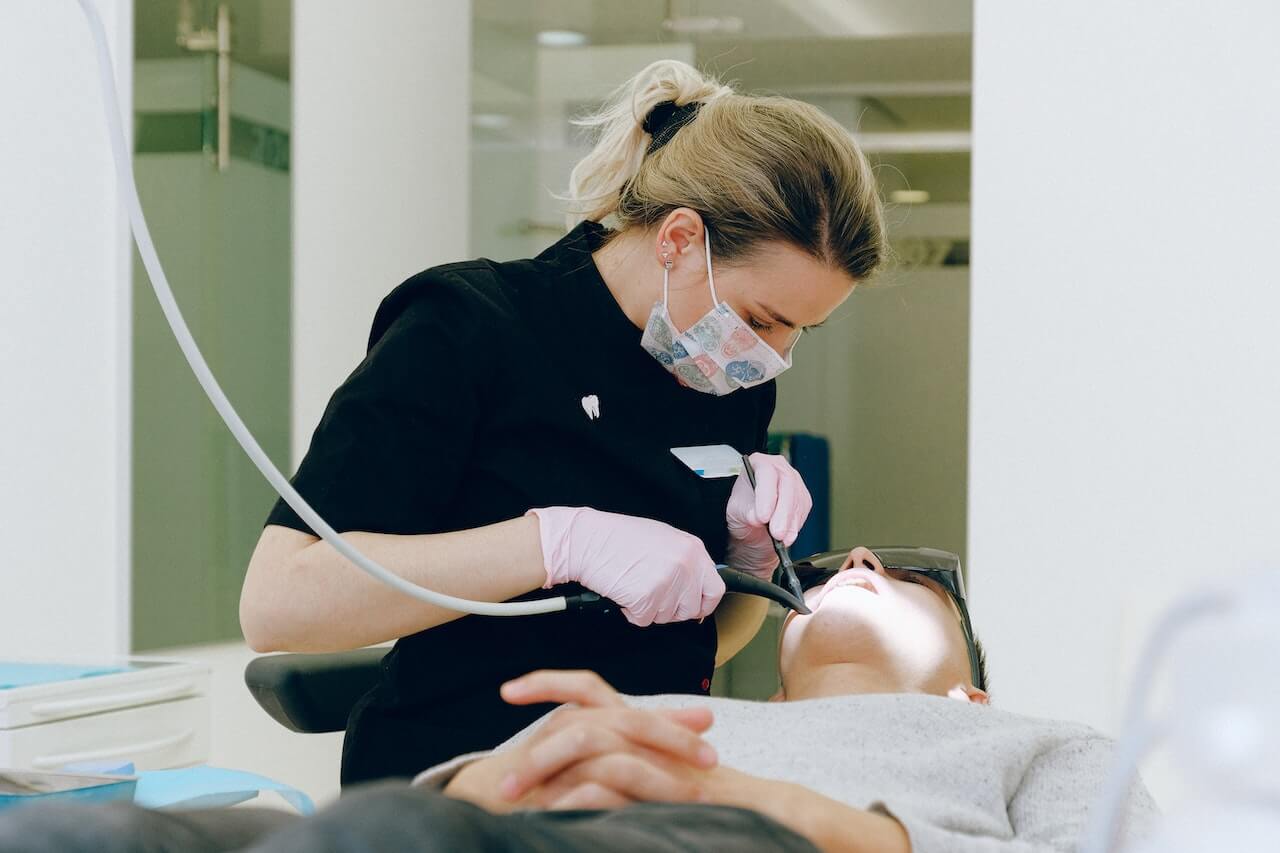Bad breath, or what's scientifically called halitosis, is a common experience that can affect your confidence and interactions with others. If you're concerned you're alone, don't be; bad breath is one of those topics many are too embarrassed to talk about, but it's estimated that around 50 million people in the U.S. struggle with halitosis.
Bad breath is caused by the chemical compounds found in the breath you exhale, volatile sulfur compounds (VSCs) for mouth-related problems, and volatile organic compounds (VOCs) stemming from issues outside the mouth (like digestive conditions).
Many attribute the causes of bad breath to oral health, and while dental problems are the most common problem, it's not the only cause. Gastrointestinal health concerns can also play a role, so if you're dealing with bad breath, it's essential to look at all the possible root causes.
This article will delve into the connection between bad breath from stomach problems (and other potential issues), explore the impact of diet and lifestyle, and provide practical guidance for those seeking relief.
{{mid-cta}}
Causes and Symptoms of Your Bad Breath
Bad breath from the stomach is one possibility, but there are other possible causes to consider, each with its own symptoms and treatments. Let's look at each common cause in more detail:
- Gum disease: The first consideration is oral hygiene and gum disease. Bacteria and plaque in the gums can trap food particles, causing bad breath. This can be accompanied by bleeding, swollen, tender, or receding gums.
- Tooth anatomy: Some people have naturally deep canals in their molars, which bacteria can use as refuges. Extra bacterial growth can equal bad breath.
- Post-nasal drip: If you constantly feel the need to clear your throat or suffer from allergies, it could contribute to bad breath. The mucous can trap bacteria and food particles, leading to odors.
- Ketogenic diet: Some people who follow a ketogenic diet (a very low-carb, high-fat diet) report bad breath due to increased production of ketones. Usually, this occurs initially as the body adapts to the diet and eventually goes away, but it can sometimes persist.
- Foods: Certain foods like garlic and onions are more aromatic and can contribute to bad breath. These foods aren't necessarily a concern for everyone who eats them, but if you're prone to bad breath, they could add to the problem.
- Gastroesophageal reflux disease (GERD): GERD is where food, bile, and stomach acid move back into the esophagus from the digestive tract, causing painful symptoms and sometimes sour-smelling breath.2
- Irritable bowel disease (IBD): Crohn's disease and ulcerative colitis are the two types of IBD that cause inflammation and changes in the anatomy of the intestines. Some research links alterations in digestion and the GI tract from IBD with bad breath.
- Small intestinal bacterial overgrowth (SIBO): SIBO is a condition where bacteria in the small intestine grow in amount or variety. It can cause digestive system issues, bad breath, bloating, and other symptoms.
- H. Pylori and stomach ulcers: H. Pylori is a bacteria many people naturally have in the stomach, but too much can cause issues like stomach ulcers. Both H. Pylori and ulcers can cause digestive symptoms and bad breath.
- Liver disease: Liver disease is often accompanied by a high production of VOCs in the breath that can contribute to bad breath. Some research suggests using breath measurements to help diagnose chronic liver disease.
- Kidney disease: Your kidneys filter toxins out of your body. When they aren't working as well as they should, the build-up of toxins combined with medications that lower saliva production can lead to bad-smelling breath.
While it's estimated that 90% of halitosis cases are related to oral health, the remaining 10% of reasons may be related to stomach problems and can be very serious.3 If you have been to a dentist and they've ruled out oral reasons for bad breath, meeting with your doctor to rule out any other causes and medical conditions is vital.

Other Related Symptoms
Your healthcare provider can help you determine if stomach or digestive issues cause your bad breath. Still, if you also experience any of the following symptoms, it could be a hint there's a connection:
- Nausea
- Abdominal pain
- Bloating
- Burping
- Loss of appetite
- Weight loss
- Peptic ulcers
What Your Diet Says About Your Breath
A simple explanation for bad breath may also be related to your food. It's worth noting that these foods aren't a problem for everyone, but if you already suffer from bad breath, they may worsen your condition. Some of the foods most commonly linked to bad breath include:
- Garlic
- Onions
- Spicy dishes
- Coffee
- Dairy products
- Alcohol-based beverages
Many foods on this list are hard to digest for people with digestive issues like irritable bowel syndrome (IBS) or acid reflux. Addressing diet to optimize digestion could be a way to eliminate bad breath and find foods that trigger the condition. If you aren't sure where to start, working with a dietitian can help you create a digestive-friendly diet to feel better and eliminate bad breath.
How to Improve Your Breath: 5 Practical Tips
From worrying about meetings to being aware of your breath when talking to people, bad breath can significantly impact your quality of life and self-confidence. Fortunately, there are many small changes you can make to improve your breath:
- Practice good oral hygiene: Brushing your teeth and tongue and flossing regularly can help reduce bacteria levels in your mouth, decreasing bad breath.
- Visit your dentist regularly: A professional cleaning can remove plaque and bacteria, reducing bad breath.
- Modify your diet: As noted above, diet isn't necessarily the culprit, but reducing the amount of certain foods like garlic and onions could help while you work on other solutions.
- Drink plenty of water: Water helps keep your mouth hydrated and increases saliva production, which can help to reduce bad breath. A dry mouth is associated with bad breath.
- Try probiotics: You've probably heard about the gut microbiome and how it affects your health, but you also have an oral microbiome that protects against harmful bacteria in your mouth. More than 700 species of bacteria reside in the oral cavity3
Certain probiotic strains have been shown to support both digestive and oral health. For example, S. saliviarius is a type of oral bacteria naturally found in the mouth that helps combat bad breath. Some studies suggest S. saliviarius may help balance the oral microbiome and reduce plaque build-up that could contribute to bad breath.

Get Rid of Bad Breath with Medication
As much as home remedies and over-the-counter solutions can help, it's important to emphasize that seeking professional medical attention is crucial when experiencing discomfort or persistent issues related to bad breath. If bad breath continues despite your best efforts to maintain oral hygiene, it could indicate other underlying health issues.
Bad breath accompanied by symptoms like burping, nausea, constipation, heartburn, indigestion, or stomach pain shouldn't be ignored and require medical attention as they could indicate a more serious health condition.
Depending on the root cause, your doctor or dentist may suggest over-the-counter or prescription-strength medications to treat bad breath. These may include:
- Histamine blockers (H2 blockers) or proton pump inhibitors (PPIs) to address reflux and heartburn.
- Antacids to neutralize stomach acids.
- Antibiotics to treat bacterial infections in the throat, sinuses, or lungs.
- Nasal sprays and decongestants for allergies or rhinitis.
- Mouthwash containing chlorine dioxide to reduce the number of oral bacteria.
- Chewing gum or mints that contain xylitol which helps reduce plaque build-up.
Make sure you discuss all side effects and long-term plans with your doctor before taking any medication so you can make an informed decision for your body.
Learn More About How to Manage Gut Health with Signos' Expert Advice
The Signos app, combined with a continuous glucose monitor (CGM), can help you take steps to better manage gut health and resolve bad breath.
The Signos app assists in logging and analyzing your day-to-day meals, providing valuable insights into your diet patterns. Coupled with CGM, it allows for a better understanding of how different foods affect your glucose levels, which can directly affect many aspects of your health.
By keeping track of your food intake, you can make informed nutrition decisions to help manage and mitigate gut health or share with your practitioner to optimize your treatment plan. You can learn more about nutrition and healthy habits on Signos' blog or find out if Signos is a good fit for you by taking a quick quiz here.
- Item 1
- Item 2
- item 3
Topics discussed in this article:
References
- Madhushankari, G. S., Yamunadevi, A., Selvamani, M., Mohan Kumar, K. P., & Basandi, P. S. (2015). Halitosis - An overview: Part-I - Classification, etiology, and pathophysiology of halitosis. Journal of pharmacy & bioallied sciences, 7(Suppl 2), S339–S343. https://doi.org/10.4103/0975-7406.163441
- Poniewierka, E., Pleskacz, M., Łuc-Pleskacz, N., & Kłaniecka-Broniek, J. (2022). Halitosis as a symptom of gastroenterological diseases. Przeglad gastroenterologiczny, 17(1), 17–20. https://doi.org/10.5114/pg.2022.114593
- Karbalaei, M., Keikha, M., Kobyliak, N. M., Khatib Zadeh, Z., Yousefi, B., & Eslami, M. (2021). Alleviation of halitosis by use of probiotics and their protective mechanisms in the oral cavity. New microbes and new infections, 42, 100887. https://doi.org/10.1016/j.nmni.2021.100887
- Izidoro, C., Botelho, J., Machado, V., Reis, A. M., Proença, L., Alves, R., & Mendes, J. J. (2021). Periodontitis, Halitosis and Oral-Health-Related Quality of Life-A Cross-Sectional Study. Journal of clinical medicine, 10(19), 4415. https://doi.org/10.3390/jcm10194415
- Aylıkcı, B. U., & Colak, H. (2013). Halitosis: From diagnosis to management. Journal of natural science, biology, and medicine, 4(1), 14–23. https://doi.org/10.4103/0976-9668.107255
- Kumar, K. M., Nachiammai, N., & Madhushankari, G. S. (2018). Association of oral manifestations in ulcerative colitis: A pilot study. Journal of oral and maxillofacial pathology : JOMFP, 22(2), 199–203. https://doi.org/10.4103/jomfp.JOMFP_223_16
- Dou, W., Li, J., Xu, L., Zhu, J., Hu, K., Sui, Z., Wang, J., Xu, L., Wang, S., & Yin, G. (2016). Halitosis and helicobacter pylori infection: A meta-analysis. Medicine, 95(39), e4223. https://doi.org/10.1097/MD.0000000000004223
- De Vincentis, A., Vespasiani-Gentilucci, U., Sabatini, A., Antonelli-Incalzi, R., & Picardi, A. (2019). Exhaled breath analysis in hepatology: State-of-the-art and perspectives. World journal of gastroenterology, 25(30), 4043–4050. https://doi.org/10.3748/wjg.v25.i30.4043
- Santaella, N. G., Maciel, A. P., Simpione, G., & Santos, P. S. (2020). Halitosis, reduced salivary flow and the quality of life in pre-kidney transplantation patients. Journal of clinical and experimental dentistry, 12(11), e1045–e1049. https://doi.org/10.4317/jced.57282
- van Lanen, A. S., de Bree, A., & Greyling, A. (2021). Efficacy of a low-FODMAP diet in adult irritable bowel syndrome: a systematic review and meta-analysis. European journal of nutrition, 60(6), 3505–3522. https://doi.org/10.1007/s00394-020-02473-0
- Setia, S., Pannu, P., Gambhir, R. S., Galhotra, V., Ahluwalia, P., & Sofat, A. (2014). Correlation of oral hygiene practices, smoking and oral health conditions with self perceived halitosis amongst undergraduate dental students. Journal of natural science, biology, and medicine, 5(1), 67–72. https://doi.org/10.4103/0976-9668.127291
- Babina, K., Salikhova, D., Polyakova, M., Svitich, O., Samoylikov, R., Ahmad El-Abed, S., Zaytsev, A., & Novozhilova, N. (2022). The Effect of Oral Probiotics (Streptococcus Salivarius k12) on the Salivary Level of Secretory Immunoglobulin A, Salivation Rate, and Oral Biofilm: A Pilot Randomized Clinical Trial. Nutrients, 14(5), 1124. https://doi.org/10.3390/nu14051124
- Kapoor, U., Sharma, G., Juneja, M., & Nagpal, A. (2016). Halitosis: Current concepts on etiology, diagnosis and management. European journal of dentistry, 10(2), 292–300. https://doi.org/10.4103/1305-7456.178294





.jpg)


























